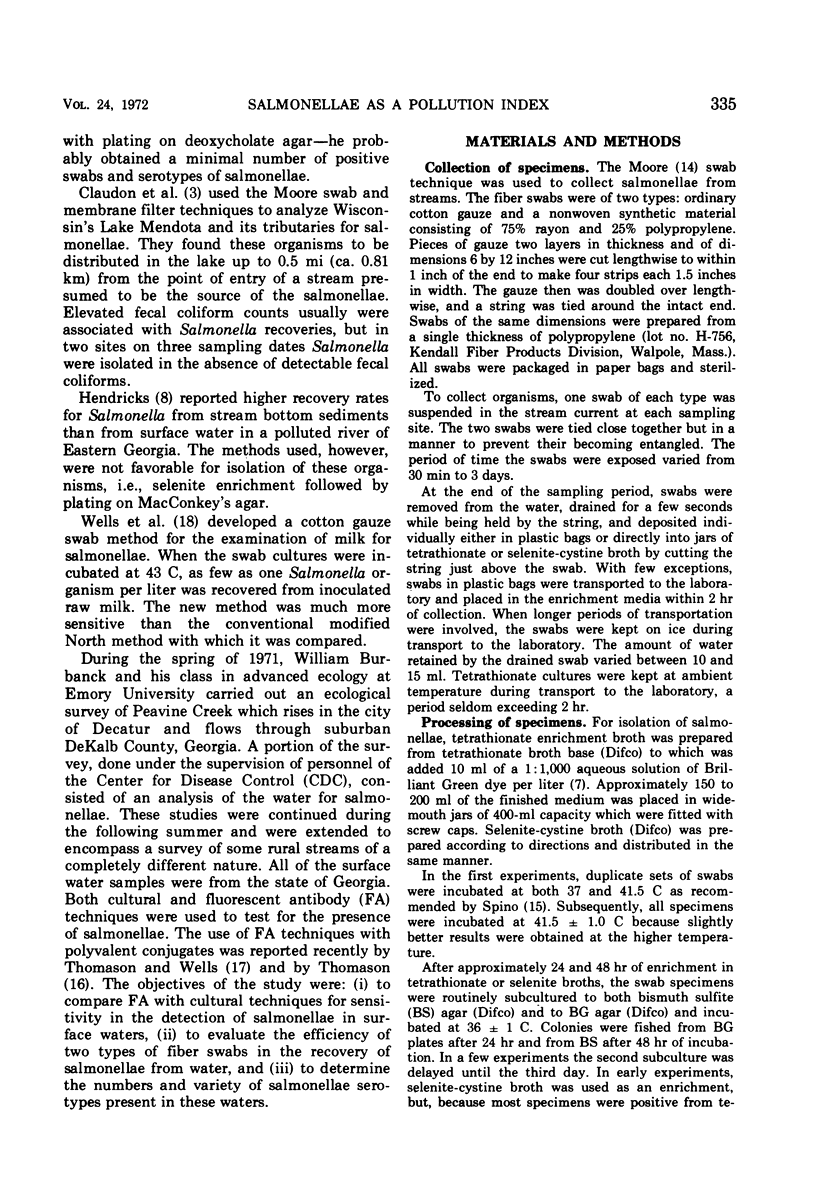Abstract
Screening enrichments of surface water specimens by means of a polyvalent fluorescent antibody reagent for the salmonellae yielded approximately 60% more positive specimens than was obtained by cultural procedures. It is not known what fraction of the excess of fluorescent antibody-positive over culturally positive specimens represents staining of non-salmonellae or non-arizonae as opposed to the staining of non-cultivatable organisms of these two genera. Cotton gauze and rayon-polypropylene fiber swabs were equally sensitive for collecting salmonellae from the streams examined. Tetrathionate enrichment incubated at 41.5 C appeared to be superior to selenite-cystine for isolation of salmonellae from surface waters. Twenty-eight serotypes of Salmonella and two serotypes of Arizona were identified in the 121 positive specimens. In water rated moderately polluted, 65% of all specimens tested were positive; in minimally polluted waters, 38% were positive; and in unpolluted streams, 44% were positive.
Full text
PDF






Selected References
These references are in PubMed. This may not be the complete list of references from this article.
- Claudon D. G., Thompson D. I., Christenson E. H., Lawton G. W., Dick E. C. Prolonged Salmonella contamination of a recreational lake by runoff waters. Appl Microbiol. 1971 May;21(5):875–877. doi: 10.1128/am.21.5.875-877.1971. [DOI] [PMC free article] [PubMed] [Google Scholar]
- GALTON M. M., LOWERY W. D., HARDY A. V. Salmonella in fresh and smoked pork sausage. J Infect Dis. 1954 Nov-Dec;95(3):232–235. doi: 10.1093/infdis/95.3.232. [DOI] [PubMed] [Google Scholar]
- Hooper R. S. The recovery of Salmonella dublin from rivers in Anglesey. Vet Rec. 1970 Nov 7;87(19):583–586. doi: 10.1136/vr.87.19.583. [DOI] [PubMed] [Google Scholar]
- KENNER B. A., ROCKWOOD S. W., KABLER P. W. Isolation of members of the genus Salmonella by membrane filter procedures. Appl Microbiol. 1957 Sep;5(5):305–307. doi: 10.1128/am.5.5.305-307.1957. [DOI] [PMC free article] [PubMed] [Google Scholar]
- Spino D. F. Elevated-temperature technique for the isolation of Salmonella from streams. Appl Microbiol. 1966 Jul;14(4):591–596. doi: 10.1128/am.14.4.591-596.1966. [DOI] [PMC free article] [PubMed] [Google Scholar]
- Thomason B. M. Rapid detection of Salmonella microcolonies by fluorescent antibody. Appl Microbiol. 1971 Dec;22(6):1064–1069. doi: 10.1128/am.22.6.1064-1069.1971. [DOI] [PMC free article] [PubMed] [Google Scholar]
- Thomason B. M., Wells J. G. Preparation and testing of polyvalent conjugates for fluorescent-antibody detection of salmonellae. Appl Microbiol. 1971 Nov;22(5):876–884. doi: 10.1128/am.22.5.876-884.1971. [DOI] [PMC free article] [PubMed] [Google Scholar]


